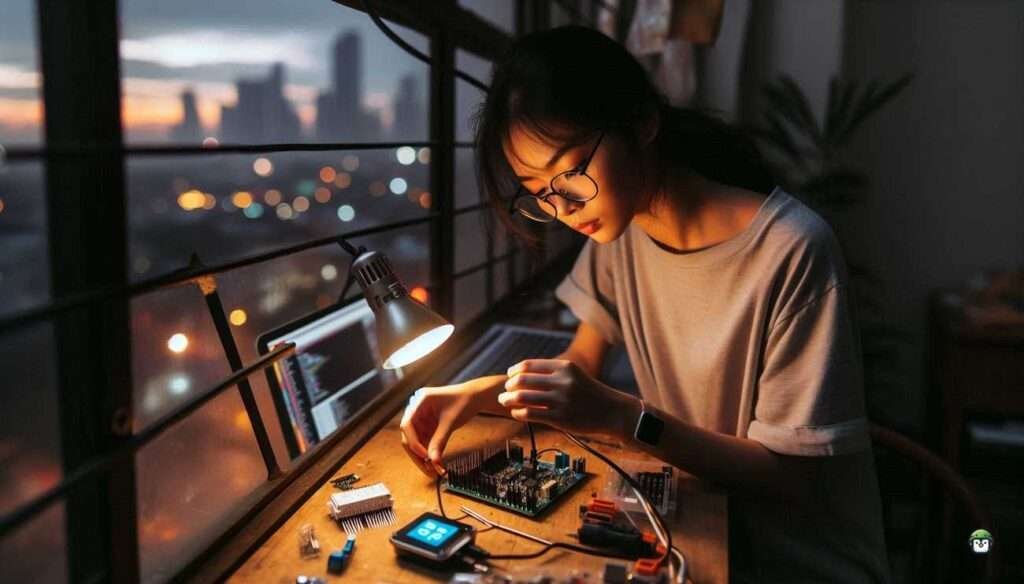What I thought would take hours with my ESP32 analog microphone setup took 12 minutes and one snack break.
The first time I tried hooking up an analog microphone to an ESP32, I expected a long night of broken breadboards and buried datasheets. I’d seen so many tutorials overcomplicating things—drowning in op-amps, I2S wiring, and overkill code for what should’ve been a simple audio input. But then I realized: sometimes, the FOSS way isn’t about finding the most advanced method—it’s about finding the most elegant one.
With just an ESP32, a KY-038 analog microphone module, and a few lines of MicroPython, I got a functional, sound-reactive setup running in under 15 minutes. No I2S. No drama. Just clear analog input and open-source tools that respect your time and hardware.
If you’re ready to cut through the noise and build something that listens—literally—read on.
- What is an Analog Microphone Sensor?
- Connecting an Analog Microphone Sensor to ESP32
- Wrap-Up: Small Sound, Big Impact
What is an Analog Microphone Sensor?
An analog microphone sensor is a device that converts sound waves into an analog electrical signal. Unlike digital microphones that process audio into a binary format, an analog microphone sensor produces a continuous signal that represents the variations in sound waves. These sensors are commonly used in audio processing, speech recognition, and noise monitoring applications.
How Does an Analog Microphone Sensor Work?
The basic principle of an analog microphone sensor is straightforward: it converts mechanical sound waves into an electrical signal. This is achieved through the following components:
- Diaphragm – A thin membrane that vibrates when exposed to sound waves.
- Transducer Element – Converts the diaphragm’s vibrations into an electrical signal. Common types include:
- Electret Condenser Microphones: Utilize a permanently charged capacitor to detect sound.
- Dynamic Microphones: Use a coil and magnet to generate an electrical signal.
- Preamp Circuit – Most analog microphone sensors include a small amplifier to boost the weak signal for better processing by the ESP32’s ADC (Analog-to-Digital Converter).
Use Cases for an Analog Microphone Sensor with ESP32
Integrating an analog microphone sensor with an ESP32 running MicroPython enables various applications, such as:
- Sound Level Monitoring: Measure environmental noise levels and trigger alerts if thresholds are exceeded.
- Voice Activation: Detect speech patterns for smart home automation.
- Acoustic Signal Processing: Analyze audio frequencies for different sound-based applications.
- IoT Applications: Send sound-related data to the cloud for further analysis.
· · ─ ·𖥸· ─ · ·
Connecting an Analog Microphone Sensor to ESP32
To interface an analog microphone sensor with the ESP32, follow these steps:
- Wiring:
- Connect the microphone sensor’s VCC to the ESP32’s 3.3V.
- Connect the GND to the ESP32’s GND.
- Connect the analog output (AOUT) of the sensor to one of the ESP32’s ADC pins (e.g., GPIO 36).
- MicroPython Code Example:
from machine import ADC, Pin
import time
mic = ADC(Pin(36)) # Connect AOUT to GPIO 36
mic.atten(ADC.ATTN_11DB) # Set attenuation for 0-3.3V range
while True:
sound_level = mic.read()
print("Sound Level:", sound_level)
time.sleep(0.1)Why Choose an Analog Microphone Sensor with ESP32?
Even with the availability of digital microphones, analog sensors offer several benefits when paired with an ESP32:
- Simple Interface: Works directly with ESP32’s ADC without requiring complex signal processing.
- Low Power Consumption: Ideal for battery-powered IoT applications.
- Cost-Effective: Analog microphone sensors are widely available and affordable.
- Versatility: Can be used in various applications from noise detection to speech-based control.
· · ─ ·𖥸· ─ · ·
Wrap-Up: Small Sound, Big Impact
Sometimes, it’s the simplest circuits that teach us the most. With an ESP32 analog microphone, you’re not just collecting raw sound—you’re opening the door to a world of reactive, responsive, and privacy-respecting audio projects. Whether you’re lighting up an LED when your dog barks, logging street noise for a civic FOSS app, or just learning the basics of ADC input, the barrier to entry is lower than ever.
Looking for the hardware specs? Here’s the KY-038 analog mic module datasheet to get you started.
Ready for more practical, ethical, and open-source embedded hacks?
👉 Join the DevDigest newsletter for weekly tools, walkthroughs, and tech deep-dives you can actually use.
Like what you’re reading?
Help keep DevDigest
free and caffeine-powered
—buy me a coffee on Ko-fi.







Leave a Reply